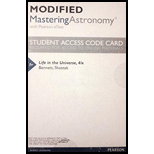
Concept explainers
Describe the journey of Pioneer 10 and illustrate the challenges of interstellar travel.
Answer to Problem 1RQ
The Pioneer 10 craft was designed for its journey to the Jupiter only. The challenges faced in the interstellar travels are the long distance to be covered and the amount of energy required to make a craft to cover such a long distance.
Explanation of Solution
The Pioneer 10 was targeted to be launched to the planet Jupiter. The craft reached its first target in a time period of 21 months. If it is considered that the Pioneer 10 continues to move at this speed then it would require almost
There are several challenges faced in the interstellar travels because of the distance that needs to be covered and also the amount of energy required for this travel. The crafts designed on earth take around
The interstellar travel also requires the space craft to be kept safe from the space debris which are found frequently in the far space regions. Therefore, these are the several challenges faced by the scientists in the interstellar travel.
Conclusion:
Thus, the Pioneer 10 craft was designed for its journey to the Jupiter only. The challenges faced in the interstellar travels are the long distance to be covered and the amount of energy required to make a craft to cover such a long distance.
Want to see more full solutions like this?
Chapter 13 Solutions
Modified MasteringAstronomy with Pearson eText -- ValuePack Access Card -- for Life in the Universe
- Q9: When a wedding ring is thrown horizontally out of a fifth-floor window 15 m off the ground, it lands 7.5 m out from the base of the building. Calculate the throwing speed; (a) (b) the impact velocity; (c) how long the marriage will last. Q10: A girl on a sled with a combined mass of 50.0- kg slides down a frictionless hill from rest. When she gets to the bottom of the hill, she is traveling at 3.00 m/s. How high is the hill?" m = 50.0 kg HILL v, 3.00 m/s ■ 0 (ground)arrow_forwardThis is data I collected from a Centripetal Acceleration and Force lab. Please help with interpreting the data, thanks!arrow_forwardAnswer thisarrow_forward
- A coin is located 20.0 cm to the left of a converging lens. (f=13.0cm). A second, identical lens is placed to the right of the first lens, such that the image formed by the combination. has the same size and orientation as the original coin. Find the separation between the lenses.arrow_forwardA converging lens (f₁ = 10.9cm) is located 33.0 cm to the left of a diverging lens (f2=-5.64 cm). A postage stamp is placed 35.4 cm to the left of the converging lens. Find the overall magnificationarrow_forwardA farsighted man uses contact lenses with a refractive power of 2.00 diopters. Wearing the contacts, he is able to yead books held no closer than 25.0 cm from would like a his eyes. He prescription for eyeglasses to serve the same purpose. What is the correct prescription for the eyeglasses if the distance from the eyeglasses to his eyes is 200 cm 2.00 dioptersarrow_forward
- from a concave lens. The An object 5.3cm tall is 25.0 cm from resulting image is two-fifths is two-fifths as large the focal length of the lens? as the object. What is as cmarrow_forwardThe drawing shows a rectangular block of glass (n=1.56) surrounded by liquid carbon disulfide (n=1.64). A ray of light is incident on the glass at point A with a O₁ = 47.0° angle of incidence. At what angle of refraction does the ray leave the glass at point B? A Barrow_forwardThere is a magic item in Dungeons & Dragons called The Baton of Many Sizes, which is a staff that can magically change lengths between 0.305 m (1 foot) long and 15.2 m (50 feet) long, though it always has a mass of 3.18 kg. Assume the moment of inertia of the staff is 112mL2112mL2 where L is the total length. The angular acceleration is 4.9075 rad/s^2, the angular velocity is 17.57 rad/s. The staff then shrinks to a length of 1.12 m while no longer applying any torque. What is the staff’s new angular velocity?arrow_forward
- Finding my misplace science book what are the steps to in the given flowchart observe and question from a hypothesis test the hypothesis analyse and then the plate form a new hypothesis is the new hypot this is form a conclusionarrow_forwardSamus Aran from the Metroid series of video games has the ability to roll into a ball to get into smaller areas. Samus rolls down a path which drops down 22.0 m. If she was at rest when she started at the top, what is her linear velocity at the bottom of the path? Treat her as a solid sphere with a moment of inertia of 2/5 mr^2 .arrow_forwardMoon Knight, from both comics and the show of the same name, has crescent shaped daggers he throws at enemies. To throw a crescent dagger he applies a force of 0.918 N at an angle of 75.0° relative to the dagger’s center of mass at a point 0.0690 m away from the dagger’s center of mass. If the crescent dagger has a moment of inertia of 2.57⋅10^−5 kg⋅m^2 , what is the angular acceleration of a crescent dagger as it is thrown?arrow_forward
 AstronomyPhysicsISBN:9781938168284Author:Andrew Fraknoi; David Morrison; Sidney C. WolffPublisher:OpenStax
AstronomyPhysicsISBN:9781938168284Author:Andrew Fraknoi; David Morrison; Sidney C. WolffPublisher:OpenStax Stars and Galaxies (MindTap Course List)PhysicsISBN:9781337399944Author:Michael A. SeedsPublisher:Cengage Learning
Stars and Galaxies (MindTap Course List)PhysicsISBN:9781337399944Author:Michael A. SeedsPublisher:Cengage Learning
 Foundations of Astronomy (MindTap Course List)PhysicsISBN:9781337399920Author:Michael A. Seeds, Dana BackmanPublisher:Cengage Learning
Foundations of Astronomy (MindTap Course List)PhysicsISBN:9781337399920Author:Michael A. Seeds, Dana BackmanPublisher:Cengage Learning Horizons: Exploring the Universe (MindTap Course ...PhysicsISBN:9781305960961Author:Michael A. Seeds, Dana BackmanPublisher:Cengage Learning
Horizons: Exploring the Universe (MindTap Course ...PhysicsISBN:9781305960961Author:Michael A. Seeds, Dana BackmanPublisher:Cengage Learning





